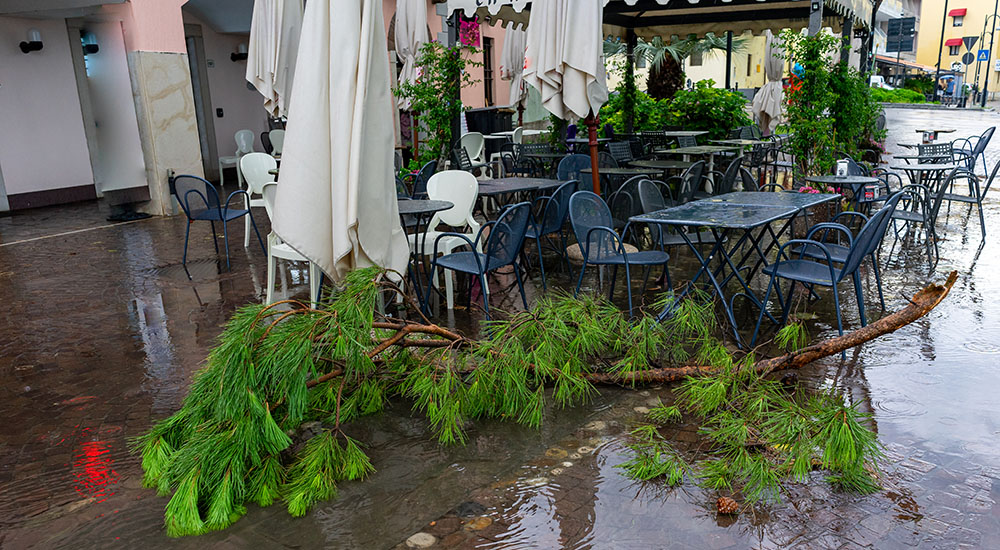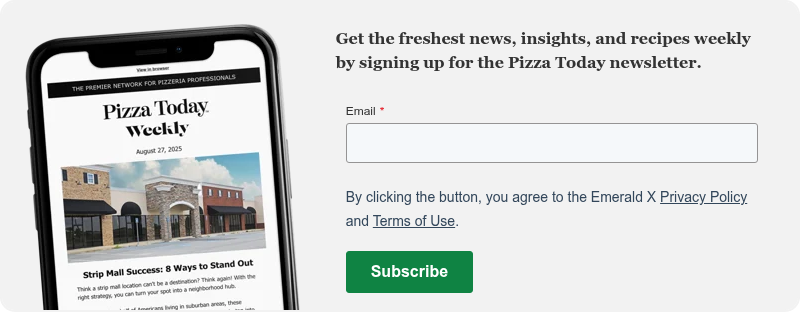When Hurricane Harvey slammed into Houston in 2017, Nicole Bean thought she knew what to expect. The owner of Pizaro’s Pizza Napoletana had weathered plenty of storms before – Houston is hurricane city, after all. But Harvey was different. It dumped 27 trillion gallons of water, sinking the city below sea level and leaving a third of Houston flooded.
Bean and her team found themselves trapped, unable to reach their restaurant for days while helicopters rescued people from rooftops. When they finally reopened, customers waited three hours for pizza that normally takes 90 seconds to cook. The grocery stores were empty, and Bean’s pizzeria became a lifeline for people who had nowhere else to turn for food.
“We didn’t have emergency procedures before Hurricane Harvey, but we do now,” Bean tells an audience at Pizza Expo 2025. Her hard-learned lessons from that disaster – and from successfully navigating Texas’s devastating freeze in 2021 – offer a blueprint for pizzeria owners who want to protect their businesses, employees, and communities when emergencies strike.
Know Your Risks
The first step in emergency planning is understanding what disasters you’re most likely to face in your area. Bean identifies four major categories that every pizzeria should prepare for:
Natural disasters vary by region – hurricanes and flooding in Houston, tornadoes in Oklahoma, earthquakes in California, blizzards in the Northeast. Research your area’s specific risks and prepare accordingly.
Electrical and fire incidents pose risks for all pizzerias, especially those working with open flames, gas lines and electrical equipment.
Water damage from pipe bursts or flooding can shut down operations quickly, particularly in colder climates where freezing pipes are common.
Power outages are perhaps the most frequent emergency pizzerias face, happening several times a year for many operators.
Create Your Emergency Procedures
Once you’ve identified potential risks, develop specific procedures for each scenario. Bean recommends creating detailed checklists that answer key questions:
- Who does management call first?
- When should staff handle situations themselves versus reaching out for help?
- What are the contact numbers for your electrician, plumber and POS company?
- How will you operate without power?
- What menu modifications will you make?
“Rule No. 1 is always call me first,” Bean emphasizes to her staff. “Let me know what’s happening.”
Document these procedures in your employee handbook and store them both digitally in the cloud and physically in a clearly labeled filing system. This dual approach ensures accessibility even when technology fails.
Establish Communication Systems
During Hurricane Harvey, Bean watched helplessly from home as her parents and brother worked alone at the restaurant. She couldn’t reach them or help coordinate operations. Now, she uses a cloud-based POS system that allows her to communicate instantly with all employees through an app.
“When we hire people, they’re not required to, but we prefer that they download the app so they can see their schedule, make requests (for time) off and get any messages in case something happens,” Bean explains.
Set up multiple communication channels:
- Employee apps or group texting systems
- Social media accounts for customer updates
- Website notifications
- Physical signage at your location
Also sign up for local emergency alerts through your city, county, and neighborhood systems. Bean uses Next Door, Facebook groups and even Snapchat’s location features to monitor conditions around her restaurants.
Prepare for Power Outages
Power outages are the most common emergency most pizzeria owners face. Bean’s approach focuses on maintaining food safety while maximizing your ability to serve customers.
Immediate steps when power goes out:
- Contact your electric company to get restoration estimates
- Move all refrigerated items to walk-in coolers, which stay cold longer
- Keep cooler doors closed except when absolutely necessary
- Shut down deck ovens immediately to preserve heat
Backup systems to consider:
- Generators for essential equipment
- Mobile card readers like Square for offline transactions
- Battery-powered lighting
- Alternative cooking methods (wood-fired ovens don’t need electricity)
Bean’s POS system can process credit cards offline, storing transaction data until internet service returns. “I can continue taking cards without that connection because it holds that information until Wi-Fi comes back on, then processes everything,” she says.
Monitor Weather and Plan Ahead
The key to successful emergency management is staying ahead of problems. Bean’s team now monitors weather forecasts 24-48 hours in advance, preparing for any predictions of severe conditions.
“If anyone says it’s going to rain, it’s going to flood, that we’re going to have a hurricane, guess what happens? We all run to the grocery store,” Bean admits. “We are panicked … but we prepare.”
When weather threatens, her team:
- Moves ingredients from prep areas to walk-in coolers
- Adjusts online ordering systems with explanatory messages
- Communicates with staff about potential schedule changes
- Prepares backup menu options
Simplify Your Operations
During emergencies, simplification becomes survival. Bean learned this lesson when Harvey forced her restaurant to serve only Neapolitan pizza because it cooks fastest and requires no electricity.
Create tiered menu plans:
- Normal operations: Full menu
- Limited power: Reduce to items requiring minimal equipment
- Emergency mode: Cheese and pepperoni pizzas only
“Ultimately, that’s our goal: Keep people fed,” Bean emphasizes. “The end of the day … you have to have food, and we can provide that.”
Train Your Team
Emergency procedures only work if your staff knows how to execute them. Like airline safety demonstrations, Bean recommends regular training sessions with managers.
Key training elements:
- Walk through each emergency scenario
- Practice using backup systems
- Clarify decision-making authority
- Review communication protocols
- Test equipment like generators and offline payment systems
“It’s important to know what the expectation is for your team if you’re not there,” Bean notes. “Setting that expectation is very important.”
Organize Your Resources
Bean recommends creating organized systems for emergency supplies, similar to mobile pizzeria operators who use bin systems for efficient setup.
Essential supplies to organize:
- First aid kits and safety equipment
- Flashlights and battery-powered radios
- Emergency contact lists
- Backup POS equipment
- Basic tools and repair supplies
Store these items in clearly labeled containers in accessible locations. For mobile operators, Bean suggests having complete setup bins ready to grab for any event.
Review Your Insurance
Insurance can provide crucial financial protection during extended closures. Bean recommends working with an insurance broker who shops multiple carriers rather than a captive agent selling one product.
Consider negotiating these coverages:
- Business interruption insurance with minimal waiting periods
- Equipment breakdown coverage
- Spoilage coverage for food loss
- Worker injury protection
“The time to negotiate is before you sign the contract,” Bean advises. “The only time you have power with insurance is before you sign.”
Test Your Plans
Bean’s team successfully navigated the January 2021 Texas freeze because they had learned from Harvey and practiced their emergency procedures.
When 4 inches of snow hit Houston, they:
- Moved all ingredients to walk-in storage
- Set up customer communications on all platforms
- Planned staffing around employee safety
- Prepared simplified menu options
- Coordinated with suppliers for extended closure
“We knew at noon we’re definitely not opening. No one’s going anywhere,” Bean recalls. They opened the next day at 4 p.m., fully stocked and ready to serve customers who hadn’t been able to shop for groceries.
Restaurant Emergency Action Plan
Like airline safety demonstrations, emergency planning is about preparation for scenarios you hope never to face. But when disaster strikes, having procedures in place can mean the difference between temporary closure and permanent shutdown.
Bean’s experience shows that emergency planning isn’t just about protecting your business – it’s about serving your community when they need you most. During Harvey, her pizzeria became a refuge for customers without power, serving as both restaurant and community center for people with nowhere else to go.
“We feed people,” Bean says simply. “Bottom line, that’s where they’re going to eat. We’re their last resort.”
Start developing your emergency procedures today. Identify your risks, create detailed response plans, train your staff, and test your systems. Your future self – and your community – will thank you when the unexpected happens.



